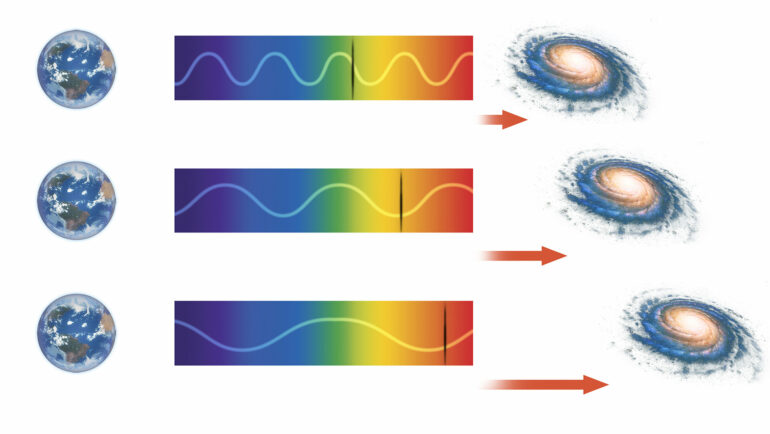A Doppler shift is defined as a change of frequency of light or sound when an object is moving toward or away from an observer. Edwin Hubble observed in 1929 that galaxies appear on average to be moving away from us (see figure above), which could indicate that the universe is expanding, an effect that became known as the Hubble Law.
An increase in the wavelength of light due to an object moving away manifests as a shift toward the red end of the optical spectrum and is therefore referred to by astronomers as a “redshift.”
In standard cosmology, due directly to the Hubble Law, redshift is also assumed to be a distance indicator.
Recent precision measurement of the cosmic microwave background is explained by the standard model as the oldest light of the universe and another method (brightest star) standard candle to support the idea that expansion of the universe is faster than what astronomers originally expected, based on the standard model understanding of the initial conditions and subsequent evolution of the universe.
Many aspects of that evolution are not fully understood. This includes the actual value of the Hubble parameter, and since this presumed constant is fundamental to standard cosmology, the prolific and continuing argument about its value is referred to euphemistically by its proponents as the Hubble tension. On the other hand, alternative cosmologists are free of this unnecessary and self-imposed conundrum.
Quantized redshift
Alternative scientists do not agree with the concept of expansion of the universe, in part due to multiple findings that extra-galactic objects exhibit redshift periodicity, also known as redshift quantization, which is characterized by the tendency of distant objects, in particular galaxies and quasars, to cluster around linear or logarithmic multiples of some particular redshift value.
In standard inflationary cosmological models, the redshift of cosmological bodies is ascribed to the expansion of the universe, with greater redshift indicating greater cosmic distance from the Earth (Hubble’s Law) and referred to as “cosmological” redshift.
Quantized redshift of cosmological objects would either indicate that they are physically arranged in a quantized pattern, or that there is an unknown mechanism for redshift that is not related to cosmic expansion and is instead referred to as “intrinsic” or “non-cosmological.”
William G. Tifft observed periodicity in galaxy redshifts, and according to Halton Arp and Geoffrey Burbidge, redshift disparities in quasars are due to an intrinsic component that is inherent to an evolutionary process.
Observation and anomalous redshift
Since 1966, some scientists have claimed that redshift is not only due to a Doppler shift. Hoyle and Narlikar (1966) observed an apparent physical association of quasars and galaxies but with different redshifts, as exemplified by a quasar with z = 2.114 very close to the nucleus of the galaxy NGC 7319 with z = 0.022.
As noted in our paper, published in Research in Astronomy and Astrophysics, Halton Arp observed many such pair cases, and there is a notable case directly observed by Lopez-Corredoira and Gutierrez (2004) with two quasars resting on a filament that connects two galaxies—all four objects have different redshifts from one another.
On the other hand, standard cosmology uses gravitational lensing to explain the apparent physical association of quasar-galaxy pairs, a phenomenon in which light from a background object is bent due to the gravity of an intervening foreground object with very large mass.
The recently observed GNz7q is a dusty starburst galaxy from which a luminous quasar is apparently emerging, a situation that is not consistent with the presence of a still young central black hole in a less massive phase at high redshift.
GN-z11 is estimated to be only 70 million years old but appears to be a moderately massive, metal-free, second-generation galaxy. JWST has observed a supermassive black hole at 200 million years after the Big Bang, which raises the question as to how this SMBH formed so quickly just after the birth of the universe. Many other observations raise fundamental questions about the formation and evolution of both galaxies and quasars.
Recent observations by JWST and other telescopes violate the standard cosmology fundamental principle that the universe is on average homogeneous and isotropic. Also violated are standard model predictions about high redshift, high luminosity, metallicity and carbon evolution in the early universe, including the presence of large filament objects, galaxies like the Milky Way and unexpected morphology of objects at both high and low redshift.
Physics of quantized redshift
The Hoyle–Narlikar variable mass hypothesis provides a framework in which quasars are ejected from galactic nuclei, starting with low mass and high redshift, extracting energy from the surrounding system, and over time, increasing in mass and decreasing in redshift, with redshift being related to mass rather than distance.
Dynamic multiple scattering is another theory that may explain redshifts dependent on environmental characteristics. In laboratory conditions, redshift has been observed between two stationary objects, where no Doppler shift is expected due to characteristics of the media in which the experiments were performed.
Conclusion
In this paper, we have used a singular-value-decomposition-based method for data analysis. We have described in our previous paper that SVD is robust in comparison to the standard method of using a periodogram to perform periodicity estimation in noisy or quasi-periodic data sets.
We have analyzed several different types of redshift dataset and with quasars alone, galaxies alone, or quasar-galaxy pairs with all of the data sourced originally from the Sloan Digital Sky Survey or the Two-degree Field (2dF). Our analyses show that redshift in certain cases does include a high intrinsic component that is definitely not of cosmological origin, in complete contrast to the conventional interpretations of quasar luminosity and galaxy metallicity, size, structure and morphology.
Concerning recent observations about extra-galactic redshifts, alternative cosmology confirms its predictions in cases that otherwise produce discrepancies when the precepts of standard cosmology are applied.
It is necessary to have observational evidence to validate any model. So the observational data like redshift periodicity of a galaxy–quasar pair gives rise to a new challenge in observational astronomy for extragalactic objects and Big Bang hypothesis.
This story is part of Science X Dialog, where researchers can report findings from their published research articles. Visit this page for information about Science X Dialog and how to participate.
More information:
Arindam Mal et al, Quantized Redshift and its Significance for Recent Observation, Research in Astronomy and Astrophysics (2024). DOI: 10.1088/1674-4527/ad6db5
Arindam Mal is a scientist at the Indian Space Research Organization in Ahmedabad, India. Mal’s interests are in cosmology, precision instrumentation and data analysis.
Sisir Roy is Professor and Senior Homi Bhabha Fellow at the National Institute of Advanced Studies in Bangalore, India. His interests are in cosmology, quantum physics, consciousness, and neuroscience.
Citation:
Quantized redshift and challenges to Big Bang hypothesis (2024, September 23)



